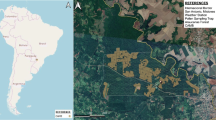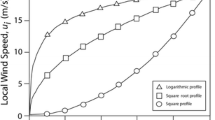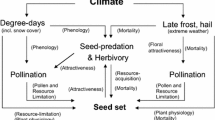Abstract
Pollen-mediated gene flow and the male reproductive success of wind-pollinated trees depend on the initial viability of the pollen and the changes that occur in its viability during transport in the atmosphere. The viability of Quercus robur pollen was determined before and during exposure to sunlight by in vitro germination and the fluorescein diacetate reaction (FCR) in 2002 and 2003, respectively. These experiments allowed us to calculate initial pollen viability and pollen sensitivity to sunlight. The germination test revealed a lower initial pollen viability (25–65%) than the FCR (53–92%). Following 9.5 h of irradiation the viability was reduced to 75–100% as determined by the in vitro germination test or to 40–70% as determined by the FCR. The actual values of initial pollen viability and pollen sensitivity to sunlight were used to define a range of values for modelling pollen dispersal using the mesoscale meteorological model METRAS. The deposition patterns of viable pollen varied by as much as a factor of 14 by changing the viability parameters in the range of the observed values. This suggests significant differences in male reproductive success. Variations in initial pollen viability have stronger effects on the gene-flow pattern than do variations in pollen sensitivity to sunlight. In particular, pollen distribution throughout the local environment is shaped by the initial pollen viability, while pollen sensitivity to sunlight mainly influences long-distance pollen dispersal.




Similar content being viewed by others
References
Aas G (1988) Untersuchungen zur Trennung und Kreuzbarkeit von Stiel- und Traubeneiche (Quercus robur L. and Q. petraea [Matt.] Liebl.). PhD thesis, LMU München, Germany
Aizen MA, Rovere, AE (1995) Does pollen viability decrease with aging? A cross-population examination in Austrocedrus chilensis (Cupressaceae). Int J Plant Sci 156:227–231
Aylor DE (2003) Rate of dehydration of corn (Zea mays L.) pollen in the air. J Exp Bot 54:2307–2312
Aylor DE (2004) Survival of maize (Zea mays) pollen exposed in the atmosphere. Agric For Meteorol 123:125–133
Dafni A, Firmage D (2000) Pollen viability and longevity: practical, ecological and evolutionary implications. Plant Syst Evol 222:113–132
Daniel WW (1990) Applied nonparametric statistics. PWS-Kent, Boston
Degen B, Streiff R, Ziegenhagen B (1999) Comparative study of genetic variation and differentiation of two pedunculate oak (Quercus robur) stands using microsatellite and allozyme loci. Heredity 83:597–603
Dow BD, Ashley MV (1998a) Factors influencing male mating success in bur oak, Quercus macrocarpa. New For 15:161–180
Dow BD, Ashley MV (1998b) High levels of gene flow in bur oak revealed by paternity analysis using microsatellites. J Hered 89:62–70
Feng HY, Li LH, Tan LL, Hou ZD, Wang XL (2000) Effect of enhanced ultraviolet-B radiation on pollen germination and tube growth of 19 taxa in vitro. Environ Exp Bot 43:45–53
Gómez-Casero MT, Hidalgo PJ, García-Mozo H, Domínguez E, Galán C (2004) Pollen biology in four Mediterranean Quercus species. Grana 43:22–30
Heslop-Harrison J, Heslop-Harrison Y (1970) Evaluation of pollen viability by enzymatically induced fluorescence-intracellular hydrolysis of fluorescein diacetate. Stain Technol 45:115–120
Heslop-Harrison J, Heslop-Harrison Y, Shivanna KR (1984) The evaluation of pollen quality, and a further appraisal of the fluorochromatic (FCR) test procedure. Theor Appl Genet 67:367–375
Hoekstra FA, Van der Wal EW (1988) Initial moisture content and temperature of imbibition determine extent of imbibitional injury in pollen. J Plant Physiol 133:257–262
Knapp EE, Goedde MA, Rice KJ (2001) Pollen-limited reproduction in blue oak: implications for wind pollination in fragmented populations. Oecologia 128:48–55
Koenig WD, Ashley MV (2003) Is pollen limited? The answer is blowin’ in the wind. Trends Ecol Evol 18:157–159
Kormutak A, Salaj J, Vookova B (1994) Pollen viability and seed set of silver fir (Abies alba Mill) in polluted areas of Slovakia. Silvae Genet 43:68–73
Lahtinen M-L, Pulkkinen P, Helander M-L (1997) Potential gene flow by pollen between English oak (Quercus robur L.) stands in Finland. For Stud 28:47–50
Lincoln RJ, Boxhall GA, Clark PF (1982) A dictionary of ecology, evolution and systematics. Cambridge University Press, New York
Loveless MD, Hamrick JL (1984) Ecological determinants of genetic-structure in plant-populations. Annu Rev Ecol Syst 15:65–95
Luna VS, Figueroa ML, Baltazar MB, Gomez LR, Townsend R, Schoper JB (2001) Maize pollen longevity and distance isolation requirements for effective pollen control. Crop Sci 41:1551–1557
Nikkanen T, Aronen T, Haggman H, Venalainen M (2000) Variation in pollen viability among Picea abies genotypes—potential for unequal paternal success. Theor Appl Genet 101:511–518
Pacini E, Franchi GG, Lisci M, Nepi M (1997) Pollen viability related to type of pollination in six angiosperm species. Ann Bot 80:83–87
Pulkkinen P, Rantio-Lehtimäki A (1995) Viability and seasonal distribution patterns of Scots pine pollen in Finland. Tree Physiol 15:515–518
Rempe H (1937) Untersuchungen über die Verbreitung des Blütenstaubes durch die Luftströmungen. Planta 27:93–147
Schlünzen KH (1990) Numerical studies on the inland penetration of sea breeze fronts at a coastline with tidally flooded mudflats. Beitr Phys Atmosph 63:243–256
Schlünzen KH, Bigalke K, Lüpkes C, Niemeier U, Von Salzen K (1996) Concept and realization of the mesoscale transport- and fluid-model ‘METRAS’. Meteorological Insitute, University of Hamburg, METRAS Techn. Rep. 5
Scholz F, Vornweg A, Stephan BR (1985) Wirkungen von Luftverunreinigungen auf die Pollenkeimung von Waldbäumen. Forstarchiv 56:121–124
Shivanna KR, Linskens HF, Cresti M (1991a) Responses of tobacco pollen to high humidity and heat stress—viability and germinability in vitro and in vivo. Sex Plant Reprod 4:104–109
Shivanna KR, Linskens HF, Cresti M (1991b) Pollen viability and pollen vigor. Theor Appl Genet 81:38–42
Sork VL, Campbell D, Dyer R, Fernandez J, Nason J, Petit R, Smouse P, Steinberg E (1998) In: Proc Workshop Gene Flow Fragmented, Managed, Continuous Populations. Research Paper No. 3. National Center for Ecological Analysis and Synthesis, Santa Barbara, California. http://www.nceas.ucsb.edu/nceas-web/projects/2057/nceas-paper3/
Snyder EB, Clausen KE (1974) Pollen handling. In: USDA (ed) Seeds of woody plants in the United States. Miscellaneous Publ No. 654, USDA For Serv, Washington D.C., pp 75–97
Sokal RR, Rohlf FJ (1995) Biometry. W.H. Freeman, New York
Stanley RG, Linskens HF (1984) Pollen - Biologie, Biochemie, Gewinnung und Verwendung. Urs Freund, Greifenberg
Streiff R, Ducousso A, Lexer C, Steinkellner H, Gloessl J, Kremer A (1999) Pollen dispersal inferred from paternity analysis in a mixed oak stand of Quercus robur L. and Q. petraea (Matt.) Liebl. Mol Ecol 8:831–841
Torabinejad J, Caldwell MM, Flint SD, Durham S (1998) Susceptibility of pollen to UV-B radiation: an assay of 34 taxa. Am J Bot 85:360–369
Tuskan GA, Tschaplinski SJ, D’Surney SJ, Nelson NT (1992) UV-B radiation reduces germination capacity in loblolly pine and red spruce. In: Colombo SJ, Hogan G, Wearn V (eds) The role of physiology and genetics in forest ecosytem research and monitoring. Proc 12th N Am For Biol Workshop. Sault Ste. Marie, Ontario, Canada, p 62
Venne H, Scholz F, Vornweg A (1988) Effects of air pollutants on reproductive processes of poplar (Populus spp.) and Scots pine (Pinus sylvestris L.). In: Scholz F, Gregorius H-R, Rudin D (eds) Genetic Effects of air pollutants in forest tree populations. Proc IUFRO Meet. Springer, Berlin Heidelberg New York, pp 89–103
Werfft R (1951a) Über die Lebensdauer der Pollenkörner in der freien Atmosphäre. Biol Zbl 70:354–367
Werfft R (1951b) Schädigt Sonnenlicht den Blütenstaub. Umschau 51:662
Winkler H, Ostrowski R, Wilhelm M (2001) Pollenbestimmungsbuch der Stiftung Deutscher Polleninformationsdienst. Takt-Verlag, Paderborn
Acknowledgements
We gratefully acknowledge the assistance of Alexandra Tusch and the helpful hints and advice of Inge Schulze for estimating the pollen viability (Institute for Forest Genetics and Forest Tree Breeding, Grosshansdorf). We appreciated the constructive comments of two anonymous reviewers on an earlier draft of the manuscript. This work is part of a joint project financed by the German Federal Ministry of Consumer Protection, Food, and Agriculture (BMVEL): “On biological diversity of forests in Germany”.
Author information
Authors and Affiliations
Corresponding author
Rights and permissions
About this article
Cite this article
Schueler, S., Schlünzen, K.H. & Scholz, F. Viability and sunlight sensitivity of oak pollen and its implications for pollen-mediated gene flow. Trees 19, 154–161 (2005). https://doi.org/10.1007/s00468-004-0376-1
Received:
Accepted:
Published:
Issue Date:
DOI: https://doi.org/10.1007/s00468-004-0376-1




